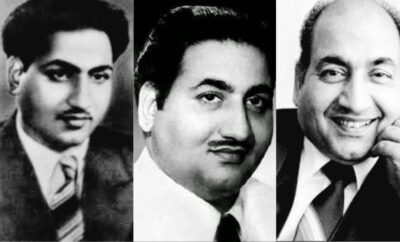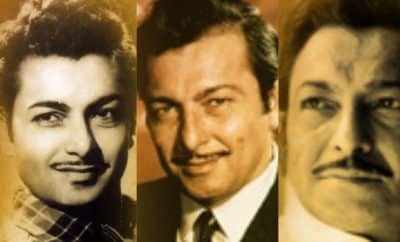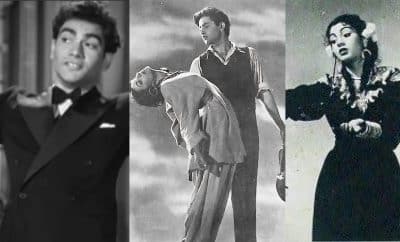Legends
Rafi and Naushad – The Mellisonant Duo of the Golden Era
A good artist may not necessarily be a good human being too. But most of the artistes of the golden era of Hindi film music were good human beings, besides being masters of their respective art. Mohammed Rafi was a glaring example of this. He was the man with a divine voice and golden heart – a master of singing and a thorough gentleman, deeply revered by the contemporaries and artistes of the subsequent generations. The purity of his heart always reflected in his voice and hence, his voice always sounds divine and unadulterated. He was the undisputed emperor of playback singing in Hindi cinema for more than 2 decades, until Kishore Kumar rose in close competition in his metamorphosed avatar from the post Aradhana period. Even then, Rafi continued to rule the playback scene alongside Kishore Kumar due to his inherent versatility and mastery over classical music. No doubt, Kishore Kumar could be considered as the most energetic and arguably the most versatile singer. Rafi’s versatility however was no less, as he could also sing songs of all genres with equal proficiency – romantic, melancholic, devotional, comedy; and also, the genres which Kishore Kumar was often hesitant in exploring – qawwali and classical songs. Rafi was always kind to the composers and producers and had little adamance about the commercials. He was therefore a preferred singer for many composers and never fell short of work. It was also sometimes alleged that he had started playing it to the gallery. But he could never say no to anyone due to the inherent kindness.
Rafi took his initial steps in Hindi cinema with the likes of Shyam Sunder and Naushad, who were the stalwarts of film music during the ‘40s. He started his career by singing group songs and singing in chorus. But his astounding capabilities were soon noticed by the composers and he soon got to sing his first solo in Anmol Ghadi (1946) under Naushad’s baton. There was no looking back after that, as his career soon took off and he started scaling new heights day by day. His alliance with Naushad however remained intact almost till Rafi breathed his last in 1980. Rafi always remained the preferred male singer in Naushad’s repertoire.
Naushad has his unique style of compositions based on folk and classical music, with the tunes mainly orchestrated with Indian musical instruments. He was one of the composers, who were instrumental in shaping up the Hindi film music during the ’40s and in the golden era thereafter. As his tunes were not simple and he was very particular about the rendition of his tunes, most of the then playback singers found it challenging to sing under his baton; yet acknowledged that they found it enjoyable and enriching to sing for him. He is ranked as one of the most successful and respected composers of the golden era.
Rafi always remained central to Naushad’s music and their long partnership gave us everlasting songs that are rich in melody. Let us have a bird’s eye view of their joint repertoire through some of their milestone songs, starting and ending respectively with Rafi’s first and last solo for Naushad.
1.Tera Khilauna Toota Balak (Anmol Ghadi – 1946)
Although Rafi had sung a few songs for Naushad in 1944 and 1945, the song “Tera khilauna toota balak” from Anmol Ghadi (1946) was the first solo for Naushad and the first solo song that he ever sang.
Though the celebrated soundtrack of the film has most of the songs sung by the three leading actors, viz. Noor Jehan, Suraiya and Surendra, it has a few songs such as this sung by other singers too. The song is picturised on a toy seller selling his toys along the street, while a group of excited kids follow him wherever he goes. Through Tanvir Naqvi’s words, the toy seller explains the precarious nature of the human life which is controlled by and dependent on an invisible force.
Naushad’s composition and Rafi’s singing adhere to the then prevalent style of film music.
2. Suhaani Raat Dhal Chuki (Dulari – 1949)
Well, who does not know this song – the song that announced the arrival of a playback singer with outstanding calibre, with a fresh voice; one of the earliest hits of Rafi. The haunting tune adorned with guitar and temple blocks among other instruments and Rafi’s poignant rendition transports you to a different world. Shakeel Badayuni’s words very effectively describe the pain of the eternal wait for the beloved.
The composition and the orchestration are quite different from Naushad’s usual style.
https://www.youtube.com/watch?v=Rw_jNbSVDGk
3. Man Tarpat Hari Dharshan Ko Aaj (Baiju Bawra – 1952)
Baiju Bawara was undoubtedly one of Naushad’s best works. Though a blend of classical and folk music had always been an important feature of Naushad’s style and classical music had been making sporadic appearance in his compositions, this was the first time he composed almost all the songs based on classical raags, of course owing to the need of the story. While the soundtrack of Rattan (1944) demonstrated Naushad’s mastery over folk music, Baiju Bawra established him as one of the best composers for songs based on raags. The soundtrack also fetched him the first and only Filmfare award.
Though all the songs in the soundtrack are euphonious, the Rafi solo “Man tarpat hari darshan ko aaj” based on raag Malkauns stands out. The essence of raag Malkauns – tranquillity laced with solemnity – makes this raag the best choice for this bhajan which expresses the intense yearning to see God. The masterpiece is the outcome of sheer genius of Naushad’s rich musical acumen, Rafi’s mature and proficient rendition and Shakeel Badayuni’s suitable words. This song – a Krishna bhajan composed, written and rendered whole heartedly by the three Muslim artistes – is one of the best examples of the true secularity of India! This is also a good example of how a musically rich song can be created even with minimum orchestration.
4. Madhuban Mein Radhika Nache Re (Kohinoor – 1960)
This is another timeless classic, another masterpiece by Naushad and Rafi. According to Naushad, when he composed this classical song based on raag Hamir, the producer was sceptical whether the public would like such a heavy classical based song. Naushad and Rafi however insisted on keeping the song in the film. What’s more, Rafi asked the producer to pay him the remuneration for this song, only if it became popular. After the film was released, the song became extremely popular. Rafi however denied accepting any money from the producer stating that the popularity of the song was his remuneration. It is also said that Dilip Kumar underwent a proper training of playing sitar for a few months, as he wanted to play it himself even in the close shots in the song, rather than using a dummy. No wonder, all these stalwarts created such masterpieces consistently.
Even if the composition has a Naushad stamp all over, it is much more fast paced and catchy as compared to Naushad’s typical style. The rich orchestration predominantly comprising violins, sitar (played by the veteran sitar player Abdul Halim Jaffer Khan), jaltarang and tabla makes sure to engross you in the song. It has been appealing to the people with the knowledge of classical music as well as those who do not know its nitty-gritties with equal force for several decades. None other than Rafi could have done this kind of justice to the emotions in the song while expertly taking care of the classical technicalities. This is yet another song written by Shakeel Badayuni in chaste Hindi, though Urdu was the mainstay of his poetry.
5. Nain Lad Jai Hai (Ganga Jumna – 1961)
This song is the rustic expression of falling in love, proficiently penned in the Poorvi dialect by Shakeel Badayuni. The master of folk music in Naushad surfaces in this song and gives us a zealous and foot tapping musical beauty filled with melody and innocence in collaboration with Rafi.
Besides Naushad’s adorable composition and Rafi’s wonderful rendition, the tragedy king Dilip Kumar’s dance is also stunning.
6. Mere Mehboob Tujhe Meri Muhabbat Ki Kasam (Mere Mehboob – 1963)
The iconic title song of the movie Mere Mehboob (1963) has two versions – one sung by Rafi and the other by Lata Mangeshkar. The Rafi version is a quintessence of the Rafi – Naushad partnership. The 7 plus minutes long version is penned by Shakeel Badayuni. Naushad’s tune is based on raag Jhinjhoti and is adorned by very few instruments like santoor and tabla – yet another example of how a musical beauty can be created even without much adornment. Rafi’s sentimental rendition perfectly expresses the hero’s urge to again meet his love, whom he has seen only once.
7. Apni Aazadi Ko Hum (Leader – 1964)
This song from the patriotic drama film Leader (1964) still finds a place among the most popular patriotic songs from Hindi films. Shakeel Badayuni’s inspirational words are set to an appropriate energetic tune by Naushad and very suitably rendered by Rafi. Whenever we listen to this song, it surely gives us goosebumps and makes us realise the value of the independence that our ancestors have brought us at the cost of so many lives and sacrifices.
8. Koi Sagar Dil Ko Behlata Nahin (Dil Diya Dard Liya – 1966)
This is a poignant ghazal written by Shakeel Badayuni and picturised on Dilip Kumar; and of course, composed by Naushad and sung by Rafi. All of them express the pang of the heart break very effectively through the words, acting, composition and rendition respectively. Again a beautiful song created by Naushad with minimum orchestration, only so much as sitar, flute and tabla.
9. Aaj Purani Raahon Se Koi Mujhe Aawaz Na De (Aadmi – 1968)
The song is the expression of grief by a devastated, dejected, lonely and broken heart, through Shakeel Badayuni’s prolific pen, Naushad’s fantastic composition and Rafi’s rendition drenched in pathos. Dilip Kumar’s wonderful acting adds to the poignancy. The reverberating effect given to Rafi’s voice coupled with visuals of the sea and the sky make the pathos of the hero very wide, all-encompassing, and far reaching.
10. Jis Raat Ke Khwab Aaye (Habba Khatoon – Unreleased)
Naushad composed this ghazal penned by Ali Sardar Zafri for the movie Habba Khatoon, that could never see the light of day. However, due to the beautiful tune composed by Naushad in raag Patdeep and decorated with santoor, sarangi, sitar, violins and tabla, Ali Sardar Jafri’s words and Rafi’s beautiful rendition, the song is still fondly remembered by the music lovers.
This was the last song rendered by Rafi for Naushad. To quote Naushad, Rafi denied accepting the remuneration for this song stating that he got to sing a beautiful song after a long gap.




Madhupati Sharma
December 25, 2020 at 12:31 pm
It will always be a difficult choice that who created the best music with Rafi- It was Shankar Jaikishan, O P Nayyar, Roshan, S D Burman, Laxmikant Pyarelal or Naushad etc.. in big league but the diamond or Kohinoor was polished first by Naushad to glourious dazzling brightness. Naushad is the most decorated music director of bollywood. With Carter Road named after him, he remains the first chapter of MDs.
Akash
December 25, 2020 at 3:19 pm
Kishor was good but if u compare with #Khudakiawaaz ❤ then my friend ur doing wrong
RAFI sahab is RAFI sahab no match for him
Madhupati Sharma
December 25, 2023 at 1:09 am
Rafi was exceptional in Romance and devotional songs, we find others not near too. Also Qawwali (Except MannaDey) , do you find any other singers? And what exceptional we find is that sonorous and soothing voice which is not matched by even closest clones.